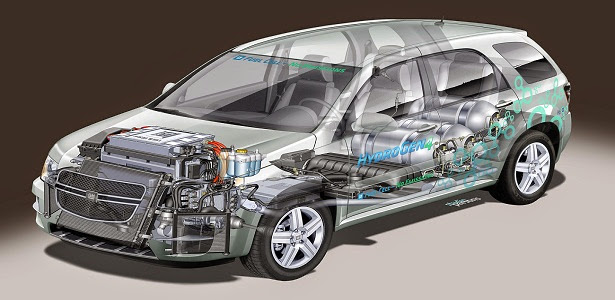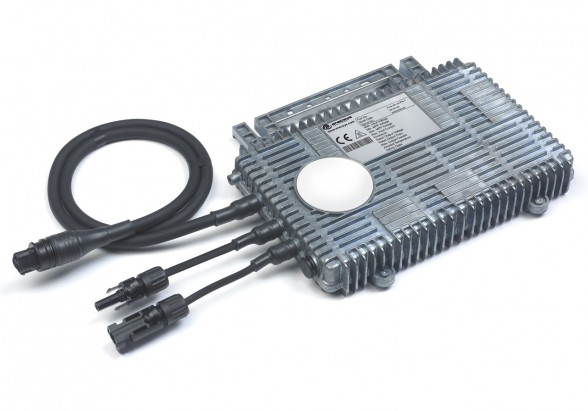The solar inverter is a critical component in a solar energy system. It performs the conversion of the variable DC output of the Photovoltaic (PV) module(s) into a clean sinusoidal 50- or 60 Hz AC current that is then applied directly to the commercial electrical grid or to a local, off-grid electrical network. Typically, communications capability is included so users can monitor the inverter and report on power and operating conditions, provide firmware updates and control the inverter grid connection. Depending on the grid infrastructure wired (RS-485, CAN, Power Line Communication, Ethernet) or wireless (Bluetooth, ZigBee/IEEE802.15.4, 6loWPAN) networking options can be used. To know more about solar inverter please view the post.
 A solar inverter, or PV inverter, converts the
A solar inverter, or PV inverter, converts the
variable direct current (DC) output of a photovoltaic
(PV) solar panel into a utility frequency alternating
current (AC) that can be fed into a commercial
electrical grid or used by a local, off-grid electrical
network. It is a critical component in a photovoltaic
system, allowing the use of ordinary commercial
appliances. Solar inverters have special f unctions
adapted f or use with photovoltaic arrays, including
maximum power point tracking and anti-islanding
protection.
 used in isolated systems where the inverter draws its DC energy f rom batteries charged by photovoltaic arrays. Many stand-alone inverters also incorporate integral battery chargers to replenish the battery f rom an AC source, when available. Normally these do not interf ace in any way with the utility grid, and as such, are not required to have anti-islanding protection.
used in isolated systems where the inverter draws its DC energy f rom batteries charged by photovoltaic arrays. Many stand-alone inverters also incorporate integral battery chargers to replenish the battery f rom an AC source, when available. Normally these do not interf ace in any way with the utility grid, and as such, are not required to have anti-islanding protection.
Follow me on Academia.edu
Function Of a Solar Inverter
 A solar inverter, or PV inverter, converts the
A solar inverter, or PV inverter, converts thevariable direct current (DC) output of a photovoltaic
(PV) solar panel into a utility frequency alternating
current (AC) that can be fed into a commercial
electrical grid or used by a local, off-grid electrical
network. It is a critical component in a photovoltaic
system, allowing the use of ordinary commercial
appliances. Solar inverters have special f unctions
adapted f or use with photovoltaic arrays, including
maximum power point tracking and anti-islanding
protection.
A little More About Solar Inverters
The engineering of these solar inverters and solar panels are designed like pieces of puzzles which should fit together in order to function. Conclusively, these solar inverters are programmed to hook up to a specific count of solar boards. The cost of inverter is practically 10 percent of the total cost of the solar board. We have to take note that these solar inverters do not have useful lives equally long as that of solar panels. This means you have to replace your solar inverters from time to time for you to use your solar system for its remaining useful life. For a solar inverter to work efficiently it should have adequate solar panels connected to it. Lesser or more panels that are connected to it could cause it not to function properly. Consequently, it should have at least 95 percent of panels hooked up to obtain optimum performance.
Classification
Solar Inverter can be classified into 4 major type.They are:- Stand-alone inverters
 used in isolated systems where the inverter draws its DC energy f rom batteries charged by photovoltaic arrays. Many stand-alone inverters also incorporate integral battery chargers to replenish the battery f rom an AC source, when available. Normally these do not interf ace in any way with the utility grid, and as such, are not required to have anti-islanding protection.
used in isolated systems where the inverter draws its DC energy f rom batteries charged by photovoltaic arrays. Many stand-alone inverters also incorporate integral battery chargers to replenish the battery f rom an AC source, when available. Normally these do not interf ace in any way with the utility grid, and as such, are not required to have anti-islanding protection.2. Grid-Tie Inverters
This type of inverters match phase with a utilitysupplied sine wave. Grid-tie inverters are designed to shut down automatically upon loss of utility supply, f or safety reasons. They do not provide backup power during utility outages.
3. Battery Backup Inverters
Thsese are special inverters which are designed to draw energy from a battery, manage the battery charge via an onboard charger, and export excess energy to the utility grid. These inverters are capable of supplying AC energy to selected loads during a utility outage, and are required to have anti-islanding protection.
4. Micro-Solar Inverter
Solar micro-inverters convert direct current (DC) from a single solar panel to alternating current (AC). The electric power f rom several micro-inverters is combined and sent to the consuming devices. The key feature of a micro-inverter is not its small size or power rating, but its one-to-one control over a single panel and its mounting on the panel or near it which allows it to isolate and tune the output of that panel.
these micro inverters are most suitable for domestic-solar PV-application where the no. of solar panels are limited to few. Detail about the Micro-solar inverter will be cited in another post.






















+and+topological+profile+image+of+fabricated+strain-gated+piezotronic+transistor+array.+An+optical+image+shows+(B)+the+transparent+and+flexible+SGPT+array+on+flexible+substrate.jpg)




























